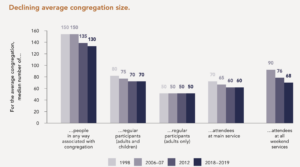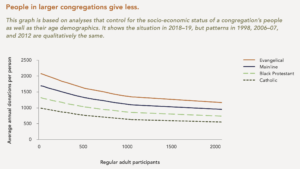One of the largest ongoing studies of communities of faith in the United States has confirmed a key finding reported by other researchers: The vast majority of American congregations are small, but the vast majority of American worshipers attend larger congregations.
This is one of many findings in the new comprehensive report of the National Congregations Study, a longitudinal study that examines congregations, not the beliefs or actions of individual congregants.
Its findings mirror those of a recent report by the Hartford Institute for Religion Research regarding the importance of congregational size as a factor in U.S. religion.
“Size is one of the most important characteristics of any organization, including congregations,” the NCS researchers explain in their summary. “It affects everything. More people mean more resources, more staff, and more programming. Large size also brings more complexity: different kinds of staff, more administration and coordination, bureaucracy, formality, and possibly a loss of the personal touch.”
“Size is one of the most important characteristics of any organization, including congregations.”
In sum: “The largest 9% of congregations contain about half of all churchgoers. Most denominations, even the largest ones, could comfortably gather the pastors of congregations representing more than half of their people in a medium-to-large hotel ballroom. And it is not just people who are concentrated in this way. Money and staff also are concentrated in the largest congregations.”
They present another way to envision this: “Imagine that we have lined up all congregations in the United States from the smallest to the largest. Imagine that you are walking along this line, starting on the end with the smallest congregations. When you get to a congregation with 360 people, you would have walked past about half of all churchgoers, but more than 90% (91%, to be exact) of all congregations. Or imagine walking along this line of congregations from the other direction, starting with the very largest. When you get to that same 360-person congregation, you would have walked past only about 9% of all congregations, but half of all churchgoers.”

In the latest year of the NCS research, 2018-2019, the median U.S. congregation had only 70 regular participants, counting both adults and children, and an annual budget of $100,000. Yet the average churchgoer attended a congregation with 360 regular participants and a budget of $450,000.
Understanding this reality explains the difficulty of denominational leaders in responding to both large and small churches, publishers in producing curriculum and resources, and seminaries in training clergy.
The researchers noted these implications as examples:
- Most seminarians come from large churches, but most clergy jobs are in small churches.
- About 70% of full-time ministerial staff and 80% of part-time ministerial staff are employed by congregations with fewer than 360 people.
- Only about one quarter of clergy serve in the largest 9% of congregations that contain about half of all churchgoers.
- Pastors of the largest churches wield political power inside denominations disproportionate to a one-congregation, one-vote point of view.
- Denominational officials can serve the most people by concentrating their attention on the largest churches, but that strategy can leave most congregations unattended.
Also mirroring the Hartford study, the NCS data show a continuing decline in attendance at the average American congregation — from 80 in 1998 to 70 in 2019.
And ironically, the growth of megachurches helps fuel the declining attendance of smaller churches, the NCS report explains. “The prominence of megachurches in many communities does not contradict or counteract this decline in average congregation size because the growth of megachurches represents people moving from smaller to larger churches. Indeed, megachurch growth contributes to rather than counteracts the trend toward decreasing average congregation size.”

Nevertheless, smaller congregations do have some advantages over larger congregations. For example, people in smaller congregations give more per capita than people in larger churches. This finding is true among Protestants, Roman Catholics, evangelicals, mainline churches, white Protestants and Black Protestants.
This corresponds to other research that finds people in smaller congregations participate more in the life of their congregations than do people in larger congregations.
Also, while larger congregations understandably employ more staff, it takes fewer staff per number of worshipers to run a large church than a small church.
The researchers explain: “Larger congregations have more people per full-time clergyperson. The participant-to-staff ratio increases sharply for all groups up to congregations having about 200 regularly participating adults. This is because, up to about 200 adults, the vast majority of congregations with any full-time staff have just one full-time clergyperson. The participant-to-staff ratio continues to increase beyond 200 adults, but less sharply, and at different rates for different groups.”
While there are variations among different types of congregations, an example may be seen in the case of predominantly white Protestant churches. Such a congregation with 200 regularly participating adults employs an average of 1.7 full-time ministers, or one minister for every 120 adults. But a white Protestant church with 500 adults has an average of 3.1 full-time ministers, or one minister for every 161 people.
These ratios change notably for Catholics and Black Protestant congregations, which tend to employ fewer ministerial staff than white Protestant congregations.
Yet another distinction between the experiences Americans have in their communities of faith is whether they attend multi-site congregations. Over the past three decades, megachurches — particularly evangelical churches — have leaned more toward creating a network of campuses served by a central hub. Sometimes this involves buying or taking over smaller congregations.
In 2019, only 6% of all U.S. congregations had multiple locations. But congregations with at least 500 adult participants were twice as likely (14%) to have multiple locations. Again, what is normative for a large number of worshipers is not normative for the larger number of congregations. In total, 11% of churchgoers worship in multisite congregations.
Congregations with at least 500 adult participants were twice as likely (14%) to have multiple locations.
While the multi-site approach has been honed by evangelical Protestants, the NCS report highlights a different kind of multi-site approach now more common among Catholics.
“The recent wave of Catholic parish mergers has created parishes that contain several church buildings and worshipping communities — a type of multisite parish. In 2018-19, three quarters (77%) of Catholic churches with fewer than 100 regularly attending adults were part of such a multisite parish.”
The National Congregations Study is directed by Mark Chaves, Anne Firor Scott Distinguished Professor of Sociology, and professor of religious studies and divinity, at Duke University. The study is made possible by major grants from Lilly Endowment. The research is based on four nationally representative surveys of congregations from across the religious spectrum — in 1998, 2006-07, 2012, and then 2018-19.
More detailed information, including cross-tabulated data, may be found at the project’s website.
Related articles:
Largest-ever U.S. congregational survey confirms what church consultants have been telling you
Most comprehensive study yet of COVID’s impact on churches finds uneven results


